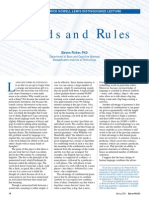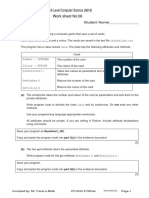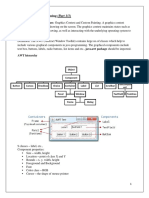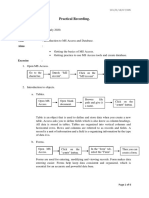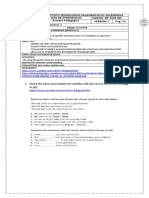Multimedia
Multimedia
Uploaded by
Ravi KumarCopyright:
Available Formats
Multimedia
Multimedia
Uploaded by
Ravi KumarOriginal Description:
Copyright
Available Formats
Share this document
Did you find this document useful?
Is this content inappropriate?
Copyright:
Available Formats
Multimedia
Multimedia
Uploaded by
Ravi KumarCopyright:
Available Formats
Multimedia Lab
06420902712
MULTIMEDIA
TECHNOLOGY
LAB FILE
ETCS-360
Made By:
Submitted To:
RAVI KUMAR
Ms. Priyanka
09120902712
Multimedia Lab
06420902712
INDEX
S.No.
AIM
PAGE DATE
OF DATE
OF TEACHERS
NO.
PRACTICAL SUBMISSION SIGNATURE
Multimedia Lab
06420902712
Experiment No. 1
Objective: Introduction to MATLAB and basic operations on images
1. What is MATLAB?
MATLAB stands for MATrix LABoratory, is a high-performance language for technical
computing. It integrates computation, visualization, and programming environment.
Furthermore, MATLAB is a modern programming language environment: it has
sophisticated data structures, contains built-in editing and debugging tools, and supports
object-oriented programming. Its ideal for research and data analysis purposes.
MATLAB has many advantages compared to conventional computer languages (e.g., C,
FORTRAN) for solving technical problems.
It has powerful built-in routines that enable a very wide variety of computations. It also has
easy to use graphics commands that make the visualization of results immediately available.
Specific applications are collected in packages referred to as toolbox. There are toolboxes
for signal processing, symbolic computation, control theory, simulation, image procesing,
and several other fields of applied science and engineering.
2. Image Processing Toolbox provides a comprehensive set of reference-standard
algorithms, functions, and apps for image processing, analysis, visualization, and
algorithm development.
This Toolbox provides image manipulation capabilities, handles a wide range of image
formats and allows creation of contours or histograms.
3. Basic Image Handling Functions
S.No.
Function Name
Syntax
Description
imread()
A = imread(filename, fmt)
This function reads a gray-scale
or coloured image from the file
path specified by a string named
filename.
Multimedia Lab
06420902712
fmt refers to the format in which
the file exists at the
corresponding location.
Supported types include:
'gif','bmp' etc.
The return value A is an array
containing the image data. If the
file contains a grayscale
image, A is an M-by-N array.
imshow()
figure
clc, clear, clear all
imshow(I,[low high])
imshow(I,[low high]) displays
the grayscale image I,
where [low high] ,an optional
argument,a two-element vector
that specifies the display range
for I. The value low (and any
value less than low) displays as
black and the value high (and
any value greater than high)
displays as white.
Figure creates a new figure
window using default property
values. This new figure window
becomes the current figure, and
it displays on top of all other
figures on the screen. The title of
the figure is an integer value that
is not already used by an existing
figure.
clear var;
clc clears all input and output
from the Command Window
display, giving you a "clean
screen."
After using clc, you cannot use
the scroll bar to see the history of
functions, but you still can use
the up arrow key, to recall
statements from the command
history.
clear, is used to clear the
contents of the variable whose
name is specified thereafter.
clear all clears all the variable
names.
size()
[m,n] = size(X)
It returns the size of matrix X in
separate dimensions m and n.
Multimedia Lab
06420902712
Source Code:
%Created By Abhineet Saxena
%Date: 02-Feb-2015
%File_1--Introduction To Image Processing
%-------------------------clc
%Clears all input and output from command window display
I='rice.png';
% A char variable which stores a path to a file.
Img_read=imread(I);
%imread() function belongs to Image Processing Toolkit,used for reading in
%an image.
figure(1),imshow(Img_read)
%Displays the specified image,in a figure window
[r,c]=size(Img_read);
Multimedia Lab
06420902712
Outputs:
Multimedia Lab
06420902712
Experiment No. 2
Objective: To perform bit-plane slicing of an image and create subplots based on the
output produced.
Theory:
Bit Plane Slicing
Instead of highlighting gray level images, highlighting the contribution made to total image
appearance by specific bits might be desired. Suppose that each pixel in an image is represented by
8 bits. Imagine the image is composed of 8, 1-bit planes ranging from bit plane1-0 (LSB)to bit
plane 7 (MSB).
In terms of 8-bits bytes, plane 0 contains all lowest order bits in the bytes comprising the pixels in
the image and plane 7 contains all high order bits.
This technique of image slicing is helpful in image compression,and in differentially analysing the
contribution made by each bit to the overall image.
S.No.
Function/Command Name
Syntax
Description
title()
title(str)
title(str) adds the title
consisting of a string, str, at the
top and in the center of the
current axes.
plot()
plot(I),plot(X,Y)
Plot() function plots/draws 2-D
line plot of the graphical
objects on the screen supplied
as argument(s).
plot(Y) creates a 2-D line plot
of the data in Y versus the
index of each value.
subplot()
subplot(m,n,p)
Subplot divides the figure into
an m cross n grid and creates
axes for subplot at position
specified at p.
reshape()
logical()
reshape(A,size1,size2,.. It reshapes the given array A,
sizeN)
into an array of dimensions
size1,size2,..sizeN), where
size1,size2..sizeN indicates the
size of each dimension.
L=logical(A)
L = logical(A) converts
numeric input A into an array
Multimedia Lab
06420902712
of logical values. Any nonzero
element of input A is converted
to logical 1 (true) and zeros are
converted to logical 0 (false).
histogram()
bitget()
max(A),min(A)
histogram(X),histogram Histogram function is used to
(X,nbins)
create a hitogram using the
values provided by array or
vector X. If 'nbins' not
specified, an automatic binning
algorithm creates bins of
uniform width chosen to cover
the range in X. Else, explicitly
specified using nbins
argument.
c=bitget(A, bit)
This returns the bits at
positions specified by 'bit' in
'A'.
Return the maximum and
minimum element respectively
in array A.
Source Code:
%Created by Abhineet Saxena
%Date: 9 February 2015
%~~To display bit-slicing capabilities of MATLAB and to plot the values by
%reshaping them.
%% Bit Slicing and display of subplots
figure(1);
%To Read-in the image: %
ipath='rice.png';
I=imread(ipath);
[r, c]= size(I);
%Displaying the maximum and minimum pixel number value in the scanned image%
mymax=max(I);
mymin=min(I);
%Extracting the corresponding bit slices and displaying it in the subplot%
A=bitget(I,1);
subplot(3,3,1),imshow(logical(A));
title('Subplot 1: Bit Slice 1');
A=bitget(I,2);
subplot(3,3,2),imshow(logical(A));
title('Subplot 2: Bit Slice 2');
A=bitget(I,3);
subplot(3,3,3),imshow(logical(A));
title('Subplot 3: Bit Slice 3');
A=bitget(I,4);
subplot(3,3,4),imshow(logical(A));
title('Subplot 4: Bit Slice 4');
Multimedia Lab
06420902712
A=bitget(I,5);
subplot(3,3,5),imshow(logical(A));
title('Subplot 5: Bit Slice 5');
A=bitget(I,6);
subplot(3,3,6),imshow(logical(A));
title('Subplot 6: Bit Slice 6');
A=bitget(I,7);
subplot(3,3,7),imshow(logical(A));
title('Subplot 7: Bit Slice 7');
A=bitget(I,8);
subplot(3,3,8),imshow(logical(A));
title('Subplot 8: Bit Slice 8');
subplot(3,3,9),imshow(I);
title('Subplot 9: Original Image');
%% Reshape the image and plot the histograms
figure(2);
Bimg_r=reshape(I,r*c,1);
Bimg_c=reshape(I,1,r*c);
nbins=255;
subplot(2,2,1), imshow(Bimg_r);
title('Reshaping the image in column major order');
subplot(2,2,2),hist(double(Bimg_r),nbins);
title('Histogram for the column reshaped matrix');
subplot(2,2,3), imshow(Bimg_c);
title('Reshaping the image in row major order');
subplot(2,2,4),hist(double(Bimg_c),nbins);
title('Histogram for the row reshaped matrix');
Outputs:
Multimedia Lab
06420902712
10
You might also like
- Sol3e Preint U0 Short Test 1bDocument1 pageSol3e Preint U0 Short Test 1bГалина Яковлева100% (2)
- Words and Rules - Steven Pinker, PHDDocument6 pagesWords and Rules - Steven Pinker, PHDRaajan K Sharma100% (1)
- OSI WorksheetDocument4 pagesOSI WorksheetArife Muse BorchaNo ratings yet
- COSC2429 - Intro To Programming Assessment 2 - Sem A 2021: RMIT Classification: TrustedDocument3 pagesCOSC2429 - Intro To Programming Assessment 2 - Sem A 2021: RMIT Classification: Trustedroll_wititNo ratings yet
- IM Jhtp7 Ch21Document19 pagesIM Jhtp7 Ch21msahinNo ratings yet
- TUGAS PROGDAS 01 - Program Design and Pseudo CodeDocument36 pagesTUGAS PROGDAS 01 - Program Design and Pseudo CodefreztstepNo ratings yet
- Assignment No. 1, DCCDocument5 pagesAssignment No. 1, DCCsamiaNo ratings yet
- Programming FundamentalsDocument22 pagesProgramming Fundamentalsxegago6945No ratings yet
- Creating Advertisement: Aim: To Prepare An Advertisement For A Company With Some SpecificationsDocument20 pagesCreating Advertisement: Aim: To Prepare An Advertisement For A Company With Some Specificationspradeep kumarNo ratings yet
- Elementary Concepts of Objects and Classes: Computer Applications-Lorven Public School, ChandapuraDocument11 pagesElementary Concepts of Objects and Classes: Computer Applications-Lorven Public School, Chandapuraks.ashwiniNo ratings yet
- Homework Assignment 1Document1 pageHomework Assignment 1SHAIK AMEER BABUNo ratings yet
- STD 11 Computer Chapter 2 Animation Tool SynfigDocument7 pagesSTD 11 Computer Chapter 2 Animation Tool Synfigz studio incNo ratings yet
- C++ Cheatsheet (Inc. C++2011) Cheat Sheet: by ViaDocument2 pagesC++ Cheatsheet (Inc. C++2011) Cheat Sheet: by ViauuuuuuuuuNo ratings yet
- Assignment 1 - Basics of PythonDocument2 pagesAssignment 1 - Basics of PythonAshutosh SharmaNo ratings yet
- PF Lab 4 SummerDocument5 pagesPF Lab 4 SummerTechnical InformationNo ratings yet
- 260-Photoshop Module v7c-PC For WEB-2 PDFDocument68 pages260-Photoshop Module v7c-PC For WEB-2 PDFRaquel JavinezNo ratings yet
- Excel - Lab - 1 - BasicsDocument4 pagesExcel - Lab - 1 - BasicsrahulNo ratings yet
- EER ExcerciseDocument3 pagesEER ExcerciseGenesis Izon GerodiasNo ratings yet
- STD 12 Computer Chapter 3 Designing Simple Website Using KompoZerDocument5 pagesSTD 12 Computer Chapter 3 Designing Simple Website Using KompoZerAmisha DalalNo ratings yet
- DipTrace TutorialDocument134 pagesDipTrace TutorialMetalloyNo ratings yet
- Programming in C++: Assignment Week 1Document11 pagesProgramming in C++: Assignment Week 1Mitlesh Reddy Yannam100% (1)
- Algorithm Analysis Design Lecture1 PowerPoint PresentationDocument9 pagesAlgorithm Analysis Design Lecture1 PowerPoint PresentationPedro PedNo ratings yet
- Good Questions To Ask AssemblyDocument12 pagesGood Questions To Ask AssemblyAbdul Qadeer Khan100% (1)
- Operator Precedence in JavaDocument2 pagesOperator Precedence in JavaGabriela PechNo ratings yet
- Programming in C++ Term Project Assignment: General InstructionsDocument2 pagesProgramming in C++ Term Project Assignment: General InstructionsBENNo ratings yet
- 328 33 Powerpoint-Slides 18-Debugging Chapter-18Document9 pages328 33 Powerpoint-Slides 18-Debugging Chapter-18SHUBHAMNo ratings yet
- Python Worksheet 1Document10 pagesPython Worksheet 1Vinod Srivastava0% (1)
- Lab 2 - Function and ArrayDocument4 pagesLab 2 - Function and Arrayananyasri.upadhyaNo ratings yet
- Lecture 2-Variables, Data Types and Arithmetic ExpressionsDocument35 pagesLecture 2-Variables, Data Types and Arithmetic ExpressionsthienNo ratings yet
- Python Type Conversion and Type CastingDocument5 pagesPython Type Conversion and Type CastingMadhusree VSNo ratings yet
- Lab-9 Abstract Data TypesDocument10 pagesLab-9 Abstract Data TypesRana Arsalan AliNo ratings yet
- Visual Basic ProgrammingDocument3 pagesVisual Basic ProgrammingPRINTDESK by DanNo ratings yet
- Soft Computing UNIT-5Document14 pagesSoft Computing UNIT-5titiki8724No ratings yet
- Microsoft Excel NotesDocument53 pagesMicrosoft Excel NotesChaman RaghavNo ratings yet
- VB Net Unit IDocument25 pagesVB Net Unit Ishamalu2011100% (1)
- Calculating Function PointsDocument10 pagesCalculating Function Pointskg156299No ratings yet
- Practical OOPDocument15 pagesPractical OOPfaheemrao33No ratings yet
- MAD Android LAb Manual Chapter 3Document4 pagesMAD Android LAb Manual Chapter 3علی احمدNo ratings yet
- 05 Multi-Scale Derivatives - ImplementationsDocument19 pages05 Multi-Scale Derivatives - ImplementationsKarthik UppuluriNo ratings yet
- Java Lab Assignments 2nd Year EngineeringDocument20 pagesJava Lab Assignments 2nd Year EngineeringTechno PrasadNo ratings yet
- Es202 Lecture NotesDocument235 pagesEs202 Lecture NotesEunice YourOtakuNo ratings yet
- JavaDocument36 pagesJavaPredakNo ratings yet
- Practice Worksheet-Datatypes Answers Rushabh 8B6Document3 pagesPractice Worksheet-Datatypes Answers Rushabh 8B6Rushabh BhosaleNo ratings yet
- AjithVisual Basic 6 0 Notes ShortDocument43 pagesAjithVisual Basic 6 0 Notes ShortAjith Kumar100% (1)
- Unit 5 - Event Driven ProgrammingDocument22 pagesUnit 5 - Event Driven ProgrammingdharanyaNo ratings yet
- Top and Bottom in DsucDocument7 pagesTop and Bottom in Dsucvineet883No ratings yet
- Theory QBankDocument7 pagesTheory QBankPrashant RautNo ratings yet
- UML Advanced Structural Modeling 1Document26 pagesUML Advanced Structural Modeling 1madhukedarNo ratings yet
- File Handling in PythonDocument9 pagesFile Handling in Pythonvoduykhoa2504No ratings yet
- Operator Overloading Practice QuestionsDocument3 pagesOperator Overloading Practice QuestionsGODWIN TOMNo ratings yet
- Flowcharting PartDocument37 pagesFlowcharting Part04502No ratings yet
- Structure Programming ApproachDocument23 pagesStructure Programming ApproachjayeshNo ratings yet
- AWT (Abstract Windowing Toolkit) : The AWT Is Roughly Broken Into Three CategoriesDocument21 pagesAWT (Abstract Windowing Toolkit) : The AWT Is Roughly Broken Into Three Categoriescahcet edu100% (1)
- Lab Report 01 (Ict.005)Document6 pagesLab Report 01 (Ict.005)sewmini hewage100% (1)
- OOP Assignment 1Document3 pagesOOP Assignment 1Ahsan HassanNo ratings yet
- Cs605 Collection of Old PapersDocument27 pagesCs605 Collection of Old Paperscs619finalproject.comNo ratings yet
- Week 7 SolutionDocument6 pagesWeek 7 Solutionguruprasad93927No ratings yet
- Practice Questions of Pointers and Strings: PointerDocument2 pagesPractice Questions of Pointers and Strings: PointerManishaNo ratings yet
- Topic 2 Goal Tree and Problem SolvingDocument59 pagesTopic 2 Goal Tree and Problem Solvingﻣﺤﻤﺪ الخميسNo ratings yet
- BMIweDocument6 pagesBMIweNoor-Ul AinNo ratings yet
- Introduction To The Opencv LibraryDocument6 pagesIntroduction To The Opencv Librarymihnea_amNo ratings yet
- DSP Lab6Document10 pagesDSP Lab6Yakhya Bukhtiar KiyaniNo ratings yet
- Atpdraw As User Shell For Atp SimulationsDocument20 pagesAtpdraw As User Shell For Atp SimulationsIonutz AxuNo ratings yet
- LogicEditor enUSDocument312 pagesLogicEditor enUSmehmetNo ratings yet
- 5 Lesson Plan FinalDocument21 pages5 Lesson Plan FinalRechelle Ann Macatunao AbechuelaNo ratings yet
- 100 Positive Quotes To ReadDocument102 pages100 Positive Quotes To Readnit1911qwertyNo ratings yet
- Full Data ScienceDocument161 pagesFull Data ScienceSahil DhuriNo ratings yet
- Figure of SpeechDocument3 pagesFigure of SpeechEnda Rizal WiransyahNo ratings yet
- Filipino Freedom: Recipe For Lechon KalapatiDocument2 pagesFilipino Freedom: Recipe For Lechon KalapatiClandestine 25No ratings yet
- Birla Institute of Technology and Science, Pilani, Hyderabad Campus First Semester 2020-21 Course Handout (Part-II) Date: 17.08.2020Document2 pagesBirla Institute of Technology and Science, Pilani, Hyderabad Campus First Semester 2020-21 Course Handout (Part-II) Date: 17.08.2020aviNo ratings yet
- b2b Error2Document2 pagesb2b Error2balakrishnakadapaNo ratings yet
- Bentley Sacs BrochureDocument8 pagesBentley Sacs BrochureIgnatius SamrajNo ratings yet
- Paper Title: Abstract - A Concise and Factual Abstract Is Required (Between 200 - 250 Words) - The Abstract ShouldDocument3 pagesPaper Title: Abstract - A Concise and Factual Abstract Is Required (Between 200 - 250 Words) - The Abstract ShouldPaula Mae AlonzoNo ratings yet
- Ok Teaching by Principles H Douglas Brown PDFDocument491 pagesOk Teaching by Principles H Douglas Brown PDFUser PlayNo ratings yet
- The Twelve Days of ChristmasDocument4 pagesThe Twelve Days of ChristmasCarlos Martín100% (1)
- Math7 Q1 Module-2021Document60 pagesMath7 Q1 Module-2021MA. LORRAINE ROSETENo ratings yet
- First Unit Test - English 6Document2 pagesFirst Unit Test - English 6peutoyessaminNo ratings yet
- Abel's TaleDocument10 pagesAbel's TaleScribdTranslationsNo ratings yet
- Inorganic Chemistry 11th ScheduleDocument2 pagesInorganic Chemistry 11th Schedulejaydehade07No ratings yet
- Impromptu Speech Notes For OutliningDocument7 pagesImpromptu Speech Notes For OutliningAngela NguyenNo ratings yet
- Tracxn APM Case Study 1 (Annotations)Document5 pagesTracxn APM Case Study 1 (Annotations)Payal JainNo ratings yet
- Catholicicsm and Orthodox ChristianityDocument145 pagesCatholicicsm and Orthodox ChristianityTarik Silajdžić100% (4)
- Data Sheet: Uplink (WAN)Document2 pagesData Sheet: Uplink (WAN)Ion CaramanNo ratings yet
- GREETINGSDocument5 pagesGREETINGSSiti Nur HalizaNo ratings yet
- Watch The Video and Complete The Activities With The Correct Form of The Verb Say or TellDocument5 pagesWatch The Video and Complete The Activities With The Correct Form of The Verb Say or TellCino WarNo ratings yet
- Spanish Websites WeeblyDocument16 pagesSpanish Websites Weeblyapi-280090368No ratings yet
- Iyanda C VDocument5 pagesIyanda C Vgbenga isaacNo ratings yet
- Cheat Sheet - DeploymentDocument2 pagesCheat Sheet - DeploymentBlackmorthNo ratings yet
- English 5 First Periodical Test 2022 2023 GILGEM SALES FinalDocument10 pagesEnglish 5 First Periodical Test 2022 2023 GILGEM SALES FinalJannahNo ratings yet
- Effects of The Norman Conquest On The LanguageDocument8 pagesEffects of The Norman Conquest On The LanguageАрина ХроменкоNo ratings yet

